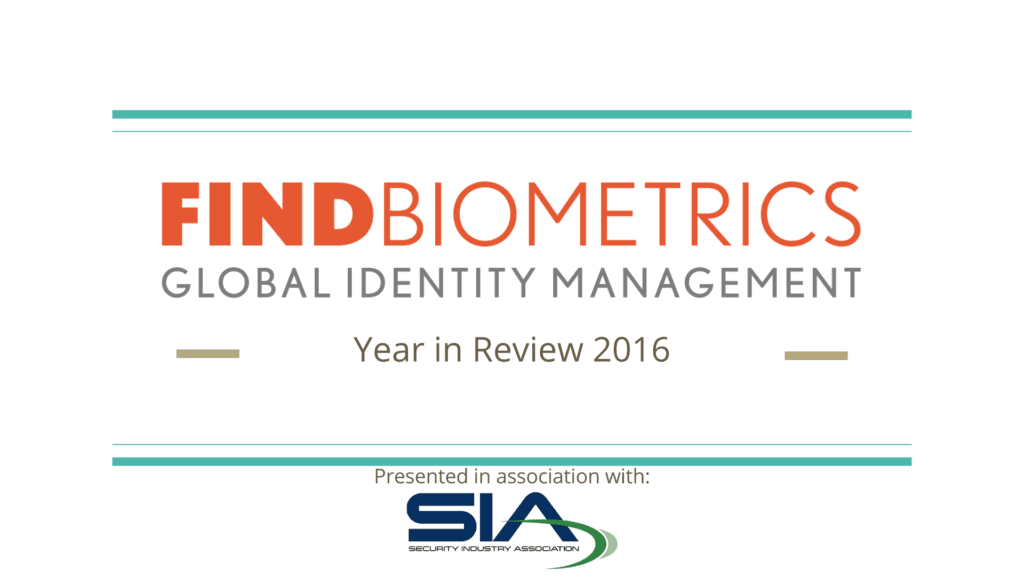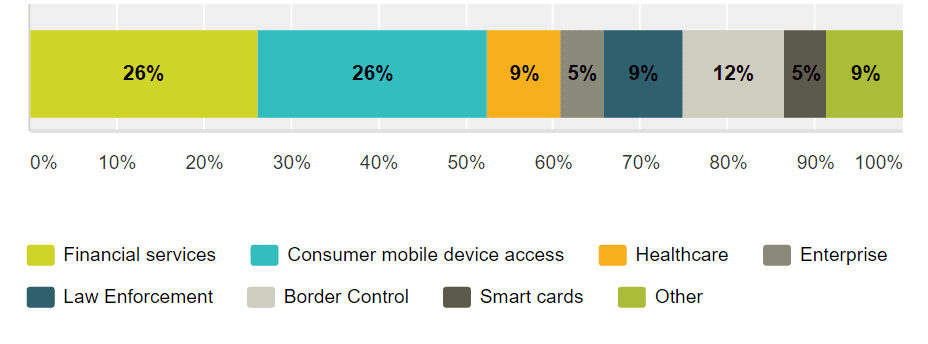In December we polled 165 professionals in biometrics and identity related industries about various topics from the past year. It was part of the FindBiometrics Year in Review, the longest-running and best regarded industry retrospective of its kind. Now in its 14th consecutive year, the FindBiometrics Year in Review is your resource to start 2017 off with your fingers on the pulse of biometrics and global identity management.

This week for our Year in Review analysis we have been looking at the areas of application for biometrics that our survey results showed to be the most interesting in 2016. In December we asked our respondents to tell us which area of application for biometrics they found the most interesting on 2016.
Here is what they said:

Yesterday we examined the first-place tie between financial services and consumer applications—two booming biometric markets that also have plenty of overlap. Today we are going to pivot and take a look at our second place entry: biometric border control.
Border Control in 2016
 In 2016 biometric border control was a dynamic space when it came to biometrics, so the interest shown in this area of application doesn’t come as much of a surprise. Long touted as a market on the rise, biometric border control exists in a space of balance between innovation, active trials, and full-on deployments—always more tangible than hypothetical promises that always seem just a few years away, but also constantly evolving along with the technology at its heart, so as to continue bringing security and convenience to border crossings.
In 2016 biometric border control was a dynamic space when it came to biometrics, so the interest shown in this area of application doesn’t come as much of a surprise. Long touted as a market on the rise, biometric border control exists in a space of balance between innovation, active trials, and full-on deployments—always more tangible than hypothetical promises that always seem just a few years away, but also constantly evolving along with the technology at its heart, so as to continue bringing security and convenience to border crossings.
Biometric Border Control In Action
 Last year saw airports embrace biometrics at an encouraging rate. Terminals in Copenhagen, Brazil, Curaçao, and Australia all deployed Vision-Box biometric screening technology, while Gemalto answered the call for biometric eGates at Paris-Charles de Gaulle and Paris Orly airports. State-side, the TSA Pre-Check security solution was kicked into high gear as MorphoTrust USA amped-up its enrollment efforts, opening IdentoGO enrollment centers across the states, and even taking its fingerprint capture tech on the road, all in the name of traveler convenience and national security.
Last year saw airports embrace biometrics at an encouraging rate. Terminals in Copenhagen, Brazil, Curaçao, and Australia all deployed Vision-Box biometric screening technology, while Gemalto answered the call for biometric eGates at Paris-Charles de Gaulle and Paris Orly airports. State-side, the TSA Pre-Check security solution was kicked into high gear as MorphoTrust USA amped-up its enrollment efforts, opening IdentoGO enrollment centers across the states, and even taking its fingerprint capture tech on the road, all in the name of traveler convenience and national security.
New biometrics technology was trialed at borders in 2016 too. One of the more high-profile cases was the US Customs and Border Protection (CBP) agency’s Otay Mesa border crossing trial, which saw multimodal identification technologies, including iris scanning, used to track non-American citizens crossing one of the country’s busiest border checkpoints. The Otay Mesa trial aims to combat international terrorism, a driving factor in many implementations of biometric technology. Charles de Gaulle, for instance, announced in April that it would be testing a facial recognition solution for security purposes.
New Attitudes and the Future of Borders
 Despite a strong focus on the convenience offered to travelers by biometric eGates and screening programs, terrorism and national security are still primary concerns in border control. To this end, the International Biometrics + Identity Association (IBIA) continued to champion biometric entry-exit in the USA, an as of yet unfulfilled legislative mandate. Thankfully, the state of the industry is in IBIA’s favor, with many of the old objections to the proposed biometric border control system having fallen away in the face of technological innovation and cost-accessibility. The association published a white paper on the topic early last year, urging the Department of Homeland Security to complete said entry-exit mandate by partnering with the biometrics industry.
Despite a strong focus on the convenience offered to travelers by biometric eGates and screening programs, terrorism and national security are still primary concerns in border control. To this end, the International Biometrics + Identity Association (IBIA) continued to champion biometric entry-exit in the USA, an as of yet unfulfilled legislative mandate. Thankfully, the state of the industry is in IBIA’s favor, with many of the old objections to the proposed biometric border control system having fallen away in the face of technological innovation and cost-accessibility. The association published a white paper on the topic early last year, urging the Department of Homeland Security to complete said entry-exit mandate by partnering with the biometrics industry.
Looking ahead, we have seen the groundwork laid for further deployments in the year to come. Japan’s Justice Ministry was seeking funding for a facial recognition system to install in airports last year, and as the clock ticks down to the Tokyo Olympics in 2020, we can expect to see more developments on this front. In Singapore, meanwhile, the Immigration and Checkpoints Authority intends to further bolster its land and sea border crossings—which already utilize fingerprint biometrics—with the addition of iris scanning slated for 2017.
Multimodality and self-service promise to be exciting trends moving forward in the market. Safran Identity & Security’s VP of Strategy and Market Development Luc Tombal illustrated the necessity of a multimodal approach to border control, sentiments shared by the experts in our Border Control Month webinar. In addition to better serving security needs, multimodality brings a flexibility and cultural nuance to the proceedings that values the passenger experience. And self-service solutions such as SITA’s SmartPath system—which was unveiled at last year’s Passenger Terminal Expo—as well as the increased popularity of advanced screening initiatives like the aforementioned PreCheck, promise to further put traveler experience in a prominent position as the industry continues to mature.
*
Stay posted to FindBiometrics throughout January as we continue to breakdown our Year in Review 2016 results.
The FindBiometrics Year in Review is presented in association with SIA and made possible by our sponsor: Tascent


Follow Us